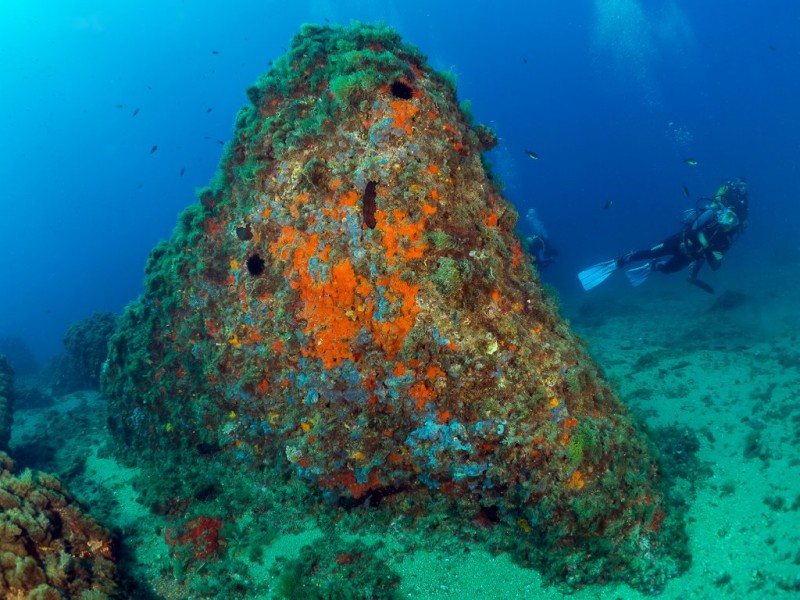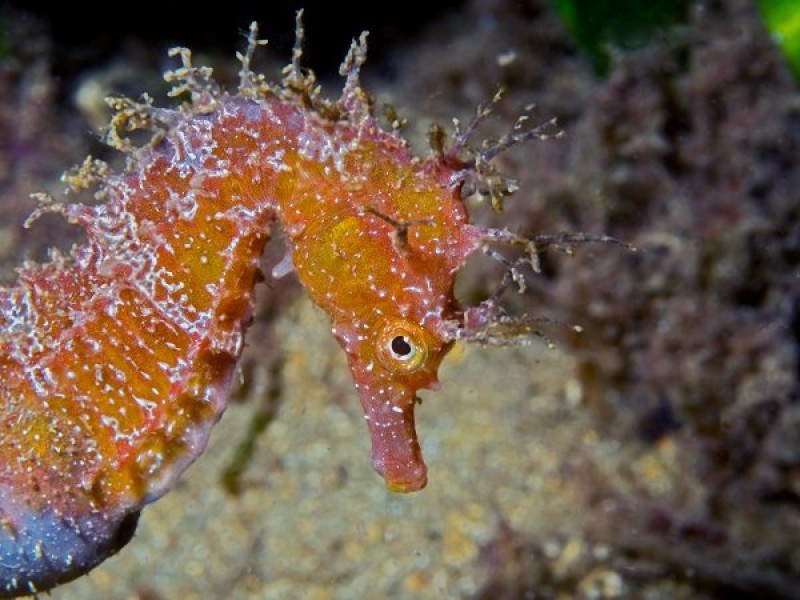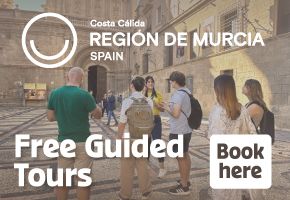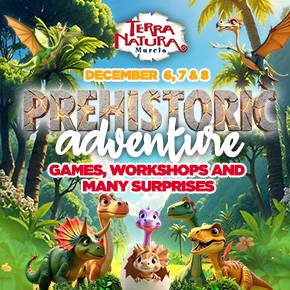
To be listed on the CAMPOSOL TODAY MAP please call +34 968 018 268.
article_detail
Diving in Águilas; popular dives and diving schools
Águilas offers exciting diving opportunities with a wealth of rocky coastline, wrecks and clear Mediterranean waters

Discover a sea of experiences in a world of tradition
Águilas, in the south-western corner of the Region of Murcia, is blessed with an enviable climate throughout the year and a coastline which remains unaltered by the passage of time. But the most special aspect of this coastline is the transparent water of the Mediterranean which, with an average temperature of 20ºC and top environmental ratings, make it a unique place for water sports including diving in a series of locations which stand out on account of the variety and wealth of species to be found there.
Setting out from the port of Águilas, a vast underwater landscape opens up before us from the craggy headland of Peñón de la Cueva de los Lobos to Punta Parda. Under the shelter of majestic cliffs and beautiful beaches there are a series of dive locations protected from the vagaries of the weather, as the nature of the coastline and the crags and mountains of the Sierra del Cantar make it possible to enjoy the water all year round, with both easterly and northerly winds effectively blocked. In addition, the westerly “poniente” hardly reaches the area, meaning that only the south-westerly “lebeche” occasionally disturbs the normally calm waters. It is always possible to find a sheltered spot to dive, and this marks Águilas out from other dive destinations along the coastline.
The various dive centres in Águilas offer dive courses and “baptisms” to cater for both beginners and experienced divers, for whom there are a host of more difficult wreck dives, caves and crevices to explore.
DIVE CENTRES
Centro de Buceo Zoea Águilas
Tel: 0034 917 398 297
Mobile: 646 412 795/610 528 004
Email: reservas@zoeaaguilas.es
www.zoeaaguilas.es
Centro de Buceo Estela
Tel: 0034 968 448 144
Mobile: 627 522 233
Email: estela@escueladebuceo.com
www.escueladebuceo.com
Centro de Buceo La Almadraba
Tel: 0034 968 419 632
Mobile: 626 95 59 58
Email: info@buceoalmadraba.com
www.buceoalmadraba.com
Click here to contact the Tourist Information office in Águilas
Click here for accommodation in Águilas
Click here for full information about Águilas in English: Águilas Today

MAIN DIVING AREAS
CABO COPE
Cueva de la Virgen
Level: All levels
Depth: 25 metres
Dive duration: 45 minutes
Description: This is a very simple dive where there are seldom currents other than very light ones, featuring a small tunnel around 12 metres long. At the entrance to the tunnel is an image of the Virgen del Carmen, who gives her name to the cave.
On emerging from the cave turn to the right and the tailplane of an aircraft at a depth of approximately 20 metres can be seen, and a little further on are two wrecks, the Ana Maria and the Nueva Mi Teresa. During the dive it is possible to observe groupers, corvina drum, dentex, white seabream, swallowtail sea perch, cardinal fish, barracuda, parrot fish, moray eels, conger eels, nudibranchs, flabellinas and occasionally sunfish and sea eels.
CABO COPE
El Montoya
Level: Advanced
Depth: 29-32 metres
Dive duration: 20 - 25 minutes
Description: The name of this dive is taken from one of the fishing boats which were sunk to create an artificial reef. These boats are approximately 25 metres long and 4 or 5 metres wide and the shelf of rock on which they lie is known as El Covacho. The fauna here includes groupers, barracuda, dentex, swallowtail sea perch, moray and conger eels, corvina drum, rock hake, saddled and white sea bream, nudibranchs and occasional sunfish. Apart from the Montoya the other two wrecks are those of the Hermanos Mayor and the Los Antonios.
CABO COPE
El Jardín
Level: All levels
Depth: 25 metres
Dive duration: 50 minutes
Description: This is a simple dive with only light currents, and it usually starts and finishes in different places. The best diving is at depths of 15 to 18 metres, where most of the features coincide in an underwater landscape resulting from rock falls from Cabo Cope: this is home to groupers, white sea bream, dentex, octopus, slipper lobsters, moray and conger eels and a large number of nudibranchs along with sea hares, rainbow and ornate wrasse and damselfish.
The rock face of El Jardín is a pleasant dive on account of the range of colours and its relative ease: it is located just before reaching the Cueva del Mármol and the dive is similar. It is normally undertaken in a westerly current as this makes it even more attractive.
The initial descent is to a platform at 8 metres, in front of which are two enormous rocks which rise from 10 metres to within a metre of the surface, and here it is common to see large groups of corvina drum and octopus taking advantage of the natural shelter in the crevices.
CABO COPE
Piedra de Santa María
The name given to this dive is derived from a large rock which can be seen balanced precariously right above the place where boats moor at the starting point, on the rock face of the “Cabezo”, a sight which has caused more than one person to exclaim “Santa María!” (Holy Mary!).
The dive is very accessible and, due to the numerous variations, is classified as being suitable for beginners (as the dive is over a sloping seabed it is quite possible to enjoy it near the surface). As with all of the dives which start and end at different locations divers generally follow the direction of the current, and this is the one which entails the least travelling by boat, being located just a little over 300 metres from the mooring point at the Cueva de la Virgen.
This dive follows a west-east route, as to follow the other direction would lead us to the “Bahía de la Seta" (or the "Yesera"), where the sea is shallow and unspectacular. Initially the descent is to around 7 metres before divers go looking for “more water” to the south-east, skirting around large boulders where all eyes are on the cavities between them, as these are home to marine life such as corvina drum, rock hake, groupers and moray eels.
CABO COPE
Cueva del Mármol
This location can be used as the start or finish point of a dive depending on the prevailing current and is an easily accessible place to enter the water –it is classified as being of low difficulty. It is known as the Cueva del Mármol (marble cave) because of the way the light plays on its white limestone walls, streaked with green algae and seaweed.
Divers usually enter the water just outside the cave, where the depth is around 5 metres and the descent is comfortable and easy: if the sea is calm it is possible to stay close to the rock face of the "Cabezo". Immediately after the descent divers head inside the cave, where depending on the season (and especially at night) they may find a large bank of "mullet" sheltering, only to hurry away when their human visitors arrive. Apart from these large mullet it is also possible to see scorpionfish sheltering in the cave before exiting and heading out to the right.
CABO COPE
Ana María
Description: This dive usually begins at one of the two fixed buoys, 7 metres apart, above a rocky platform which lies 7 metres beneath the surface. It starts at the one named the “pirulo” (or lollipop), a name given to it years ago when the descent followed a vertical PVC tube to a depth of 4 metres, while the other one is often called “la boya de Juanma”, or Juanma’s buoy.
This is an easy dive, following the buoy mooring rope downwards and, looking towards the south, observing a sizeable steamship anchor at a depth of 5 metres. This anchor can be used as a support for a safety check stop before returning to the surface, but first divers descend to the bottom of the mooring rope to begin exploring.
CABO COPE
Fontanet
This and the “Ana Maria” are both easy wreck dives, although here there is more open water and therefore divers are sometimes exposed to slightly stronger currents.
The dive can be started at two locations, depending on whether the preferred mooring point is occupied by another boat. The first of these is the one mentioned in reference to the previous dive, while the second is above a sandbank and using it means a deeper initial descent of 12 metres. After this the route usually followed remains at the same depth and heads south, leaving the rock wall on the right as divers observe medium-sized moray and conger eels and then following the wall east. With a little luck – and almost always in summer – above the rock face there may be shoals of small European barracuda.
CABO COPE
La Piedra de la Rosa
Level: Advanced (or equivalent, with at least 40 dives)
Depth: 38-40 metres
Dive duration: 10-12 minutes
Description: This is a deep dive to an area where a large boulder stands alongside a fishing boat which was sunk to create an artificial reef, and then another boat complete with propeller some 30 metres away. Around the boulder are species including sponges belonging to the Axinellidae family, swallowtail sea perch, grouper, corvina drum, dentex, Madrepora stony corals, “dead man’s fingers” coral and, on occasion, sunfish. On one occasion a small 1-metre shortfin mako shark was spotted here!
ISLA DEL FRAILE
La Cresta
Description: This is a simple dive for all levels of expertise, with a depth range of between 5 and 24 metres, increasingly progressively from 5 metres at the mooring point as the geological lie of the seabed is a slightly sloping rock surface dotted with large boulders and fallen rocks. This slope ends in a clastic coastal plain formed by fallen rocks and debris.
The dive follows a route along this rock surface, threading through the boulders, and is flanked on the west by a large meadow of Posidonia oceanica sea grass and on the south by the sandy plain. Due to it facing west, the area is protected from the weather fronts and tides which generally arrive in the area from the east, and there are no significant currents or accidents in the terrain to cause problems.
Among the marine life found here are large quantities of seaweed including Padina pavonica, Asparagopsis armata and Halopteris fillicina, while within the fauna it is possible to observe sponges (Ircinia fasciculata), anemones (Anemonia sulcata and Aiptasia mutabilis), bristle worms or polychaetes (Hermodice carunculata and Spirographis spallanzanii), urchins (Paracentrotus lividus and Arbacia lixula), and a wide variety of fish, including painted comber (Serranus scriba), salema (Sarpa salpa), two-banded sea bream (Diplodus vulgaris), damselfish (Chromis chromis), rainbow wrasse (Coris julis) and ornate wrasse (Thalassoma pavo), sometimes known in the local jargon as “fredis” or “gitanos” (gypsies).
ISLA DEL FRAILE
Pared Sur
Description: This is an intermediate level dive with a depth range of between 7 and 30 metres. The depth increases progressively from 7 metres at the mooring point to a platform at 10 metres, after which the slope becomes much steeper to at least 30 metres.
The geological features of the zone include a vertical rock wall which starts at a platform of fallen rocks and ends on a plain of clastic sediment, like other dives in the area. The dive follows this wall, making its way around the boulders while flanked on the west by a small meadow of Posidonia oceanica sea grass and on the south by the large sandy plain where spectacular specimens of Cerianthus membranaceus tube anemones can be observed. The currents do not cause any special difficulties, but this dive is deeper than others around the Isla del Fraile.
The flora and fauna found on this dive are similar to those of La Cresta and El Mogote, although the latter are more varied and better preserved.
ISLA DEL FRAILE
El Mogote
Description: El Mogote is the simplest of the three dives around the Isla del Fraile, with a depth range of between 5 and 17 metres and a lack of currents which makes it suitable for beginners.
The geological highlight is “El Mogote” itself, a large boulder which protrudes out of the water and which marks the starting point of the dive. Due to its being exposed on the eastern side this is a dive which is undertaken above all when the wind and current are coming from the west.
The seabed is covered in debris and large rocks with colonies of light-seeking corals on the platforms and higher areas and others which prefer the dark in the small shaded cavities between rocks. The fauna is rich in sponges, cnidaria, urchins and fish species similar to those found in other dives.
OTHER AREAS
La Losa
Level: Advanced
Depth: 30- 34 metres
Dive duration: 20-25 minutes
Description: A deep, intense and very beautiful dive outside the areas of Cabo Cope and Isla del Fraile, with medium visibility (15 metres). “La Losa” is a horseshoe-shaped slab of rock where it is possible to find large groupers, shoals of corvina drum nudibranchs, large sea snails and, if lucky, sunfish and sea eels alongside damselfish and ornate and rainbow wrasse.
Loading
Contact Murcia Today: Editorial 000 000 000 /
Office 000 000 000























